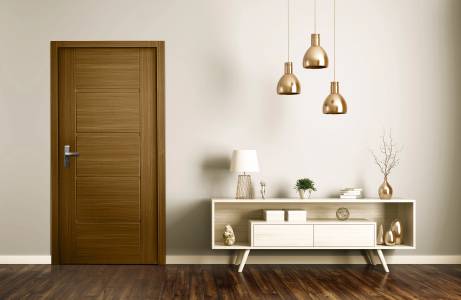Description
Solid Panel Doors vs. Traditional Wooden Doors: A Comprehensive Comparison
Choosing the right door can significantly impact your home's aesthetics, security, and energy efficiency. This guide compares solid panel doors and traditional wooden doors, highlighting their key differences to help you make an informed decision.
Solid Panel Doors: Modern Strength & Simplicity
Solid panel doors offer a clean, contemporary look with a focus on durability and ease of maintenance. They are constructed from a single, solid core material, often engineered wood, MDF (Medium Density Fibreboard), or even solid wood in some higher-end models. This core is then usually covered with a durable veneer or laminate finish.
Pros:
- Durability: Resistant to warping, cracking, and damage compared to some traditional wooden doors. The solid core provides excellent strength and stability.
- Maintenance: Easy to clean and maintain. A simple wipe-down is often sufficient. Less susceptible to scratches and dents compared to some wood types.
- Cost-effective: Generally less expensive than comparable solid wood doors, especially in larger sizes.
- Consistent Quality: Factory-made, ensuring consistent quality and dimensions across multiple doors.
- Variety of Finishes: Available in a wide array of finishes, colors, and styles to match any décor.
Cons:
- Less Character: May lack the natural grain and unique character of solid wood doors.
- Repair Difficulty: While durable, repairing damage to the surface can be more challenging than with solid wood. Replacement may be necessary for significant damage.
- Potential for Hollow Sound: Some lower-quality solid panel doors might have a hollow sound when knocked. Look for doors with a high-density core for a more solid feel.
Traditional Wooden Doors: Timeless Charm & Natural Beauty
Traditional wooden doors are crafted from solid wood, offering a classic, elegant appearance and a distinct sense of craftsmanship. They typically use a variety of wood species, each with its unique grain pattern, color, and durability.
Pros:
- Natural Beauty: Unmatched natural grain, color variations, and texture provide a unique and timeless aesthetic appeal.
- Superior Insulation: Solid wood possesses natural insulating properties, contributing to better energy efficiency.
- Resale Value: High-quality wooden doors can significantly enhance the resale value of a property.
- Repair & Refinishing: Scratches and minor damage can often be repaired or sanded down and refinished, extending their lifespan.
Cons:
- Cost: Generally more expensive than solid panel doors, especially for larger sizes and premium wood species.
- Maintenance: Require more regular maintenance, including occasional refinishing or staining to preserve their beauty and protect them from damage.
- Susceptible to Damage: More prone to warping, cracking, and swelling due to changes in humidity and temperature.
- Weight: Can be significantly heavier than solid panel doors, requiring stronger door frames and hardware.
Conclusion: Choosing the Right Door for Your Needs
The best choice between a solid panel door and a traditional wooden door depends on your priorities, budget, and aesthetic preferences. Solid panel doors offer a practical, durable, and cost-effective solution with modern aesthetics. Traditional wooden doors offer unmatched natural beauty, superior insulation, and increased resale value, but come with a higher price tag and increased maintenance requirements. Carefully consider the pros and cons of each type before making your decision.
